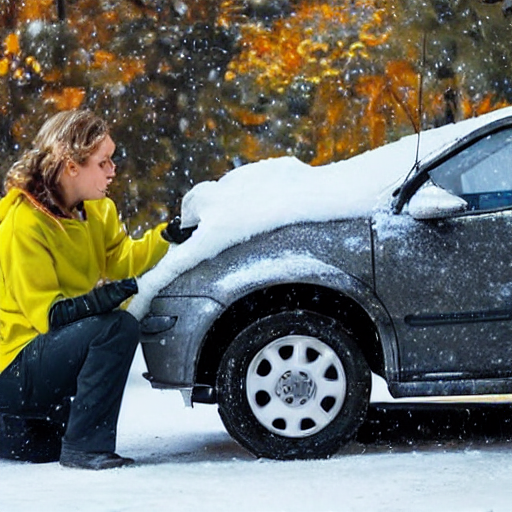Master Winter Driving: Essential Vehicle Preparation for Safe Journeys
The winter months transform our everyday surroundings into enchanting landscapes, blanketed in glistening snow, creating a picturesque backdrop that invites cozy evenings by the fire. However, this idyllic season also presents a unique set of challenges, particularly when it comes to navigating icy roads and unexpected emergencies. As diligent drivers, it is crucial to be prepared for any situation that may arise during these colder months. Just envision being ensnared in a winter storm, stranded on a lonely road with no help in sight—it’s a daunting thought. Fear not! This comprehensive guide will walk you through the vital steps necessary to ensure your vehicle is fully equipped for any winter emergency, providing you with the confidence to tackle your travels safely throughout the season.

Boost Your Safety: Remove Snow and Ice from Your Vehicle Before Driving
Prior to starting any journey, it is essential to ensure that your vehicle is completely free from accumulated snow and ice. Although this task may appear straightforward, it is often overlooked by many drivers, leading to potentially dangerous situations on the road. Snow buildup on the roof, hood, or windows can severely obstruct your vision and hinder your ability to maneuver safely. In some scenarios, snow may slide down onto your windshield while driving, resulting in an alarming loss of visibility. Moreover, large chunks of ice or snow can become hazardous projectiles, posing risks not only to your vehicle but also to other drivers. Therefore, arm yourself with a sturdy scraper and brush, and take the time to thoroughly clear all snow and ice from your vehicle’s surfaces. This proactive approach significantly enhances both your safety and that of others on the road during the winter months.
Maximize Traction and Safety: Thoroughly Inspect Your Tires for Winter Conditions
Your tires serve as the critical contact point between your vehicle and the road, making them indispensable for maintaining grip and safety when driving in winter conditions. Before the arrival of cold weather, it is imperative to assess their condition, ensuring they are properly inflated and in excellent condition. Cold temperatures can lead to a drop in tire pressure, which greatly reduces traction on icy or snowy surfaces. Always refer to the manufacturer’s recommended tire pressure levels, typically found in your vehicle’s manual or on a sticker located on the driver’s side door jamb.
Additionally, the tread depth of your tires is crucial for optimal performance in snowy and icy conditions. While the legal minimum may be 2/32 of an inch, opting for tires with deeper tread can significantly improve grip and handling capability. Consider investing in dedicated winter or snow tires designed specifically for cold, low-temperature conditions to ensure superior traction and handling. Remember, well-maintained tires can be the decisive factor that keeps you safely on the road, preventing potentially dangerous situations during winter travel.
Battery Preparedness: Guarantee Your Vehicle Starts Smoothly Every Time
Imagine being all set for your winter adventure only to find that your vehicle won’t start due to a failing battery. Avoid this frustrating scenario by taking the initiative to assess your battery’s condition before the cold temperatures arrive. Numerous auto parts retailers offer complimentary battery inspections, so take advantage of this service to ensure your battery is functioning optimally.
Winter weather can impose additional stress on your battery, making it vital to keep the terminals clean and free from corrosion. Look out for signs of aging or wear, and ensure that all connections are secure. If you notice that your battery is nearing the end of its life, it is wise to replace it preemptively, preventing the risk of being stranded in the frigid cold due to a dead battery. Maintaining your battery’s health is essential for reliable winter travel, safeguarding you from unexpected breakdowns.
Essential Fluids: Maintain Key Vehicle Fluids for Optimal Winter Performance
Keeping the right levels of essential fluids in your vehicle is critical for ensuring optimal performance during winter driving conditions. Begin by checking your engine coolant, commonly known as antifreeze, which is specifically designed to prevent your engine from freezing. It is vital to verify that this fluid is at the recommended levels to ensure efficient operation. If you are uncertain about the appropriate levels, consult your vehicle manual or seek assistance from a qualified professional.
Next, inspect your windscreen washer fluid. Winter roads can quickly become slushy, muddy, and dirty, obscuring your view. Make sure to refill your washer fluid, ideally with a winter blend that remains effective even in freezing temperatures. Don’t overlook checking your brake fluid and engine oil; ensuring these fluids are at the correct levels is essential, as cold temperatures can negatively impact their performance. Properly maintained fluids are vital for your vehicle's smooth operation and overall safety, especially during the harsh winter months.
Be Proactive: Assemble a Comprehensive Winter Emergency Kit for Your Vehicle
In the face of a winter crisis, having a well-stocked emergency kit in your vehicle is akin to having a reliable companion by your side. Ensure that your kit contains vital items such as a dependable flashlight, extra batteries, jumper cables, a reflective vest, a warm blanket, gloves, and a hat. Additionally, include a first aid kit, non-perishable snacks, and water as essential supplies to have on hand. You may also want to consider adding a portable phone charger, a compact shovel, and materials like sand or kitty litter to improve traction should you find yourself stuck.
Always remember that being prepared for the unexpected is crucial for safely navigating winter conditions. Regularly check and replenish your emergency kit to guarantee that you are equipped to handle any situation that may arise. Taking these proactive steps can make a significant difference in your safety during winter travel.
Enhance Your Safety: Verify That All Vehicle Lights are Functioning Properly
With the shorter days and longer nights that winter brings, ensuring that your vehicle’s lights are working correctly is essential for your safety. Take the time to inspect all external lights, including turn signals, brake lights, headlights, and taillights. Replace any burnt-out or dim bulbs to maintain optimal visibility for both yourself and other drivers on the road. Adequate lighting not only improves your visibility while driving but also ensures that you are easily seen by other motorists, thereby reducing the risk of accidents during crucial moments.
Wiper Blades: Ensure Clear Visibility During Severe Winter Weather
Winter weather often brings snow, freezing rain, and slushy road conditions that can severely impair visibility. To combat these challenges effectively, it is vital to have wiper blades that are in excellent working condition. If your current wipers are leaving streaks or failing to effectively clear moisture, it’s time for a replacement. Consider investing in winter-specific wiper blades designed to withstand harsh conditions, as they can significantly enhance your visibility during snowstorms and icy rain, ensuring you can navigate safely through adverse weather.
Stay Informed: Regularly Check Weather and Road Conditions for Safe Travel
To successfully navigate the challenges of winter driving, it is crucial to stay informed about current weather conditions and potential road closures. Before embarking on any journey, check the weather forecast and remain vigilant about possible hazards along your route. Utilizing weather apps, tuning into local news stations, or listening to radio announcements can provide you with real-time updates on changing conditions.
Moreover, it’s wise to inform someone of your travel plans, including your intended route and estimated arrival time. This way, should any emergencies arise, someone will know where to look for you. By following these straightforward yet effective tips, you can be well-prepared for any winter emergency, ensuring a safe journey. Remember, it’s always better to be over-prepared than caught off guard. Embrace the beauty of the winter season while ensuring your vehicle is equipped to handle whatever challenges come your way. Travel safely!
The post Preparing Your Vehicle: Stay Ahead of Winter Challenges appeared first on Survival Bite.
The Article Preparing Your Vehicle for Winter Challenges Ahead Was Found On https://limitsofstrategy.com


This post highlights such an important aspect of winter driving that is often overlooked—the necessity of ensuring our vehicles are safe before we even hit the road. Personally, I have experienced firsthand the hazards of driving with a vehicle that’s not properly prepared for winter conditions. A few years back, I underestimated the importance of clearing ice from my windshield and ended up with a compromised view that led to a near-miss.